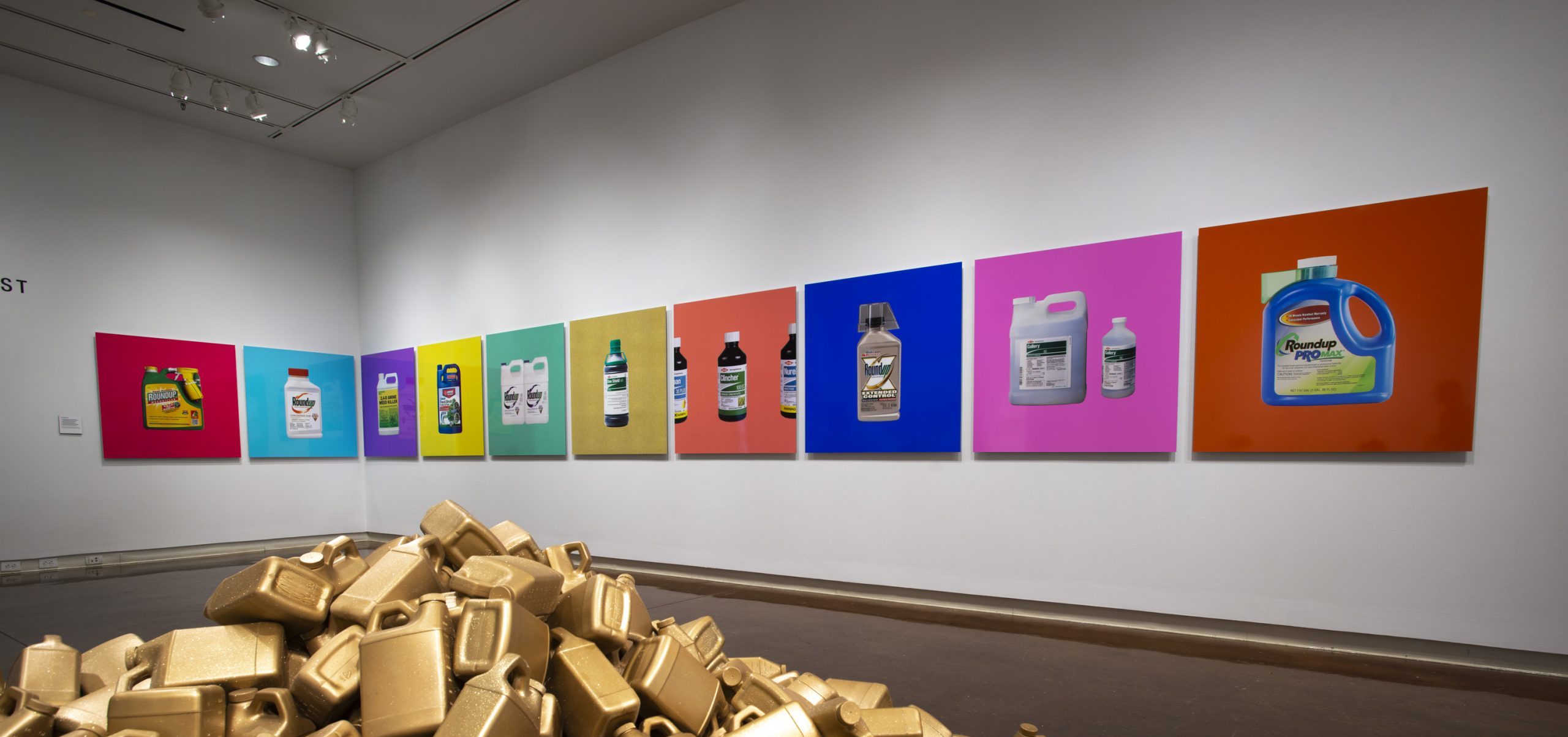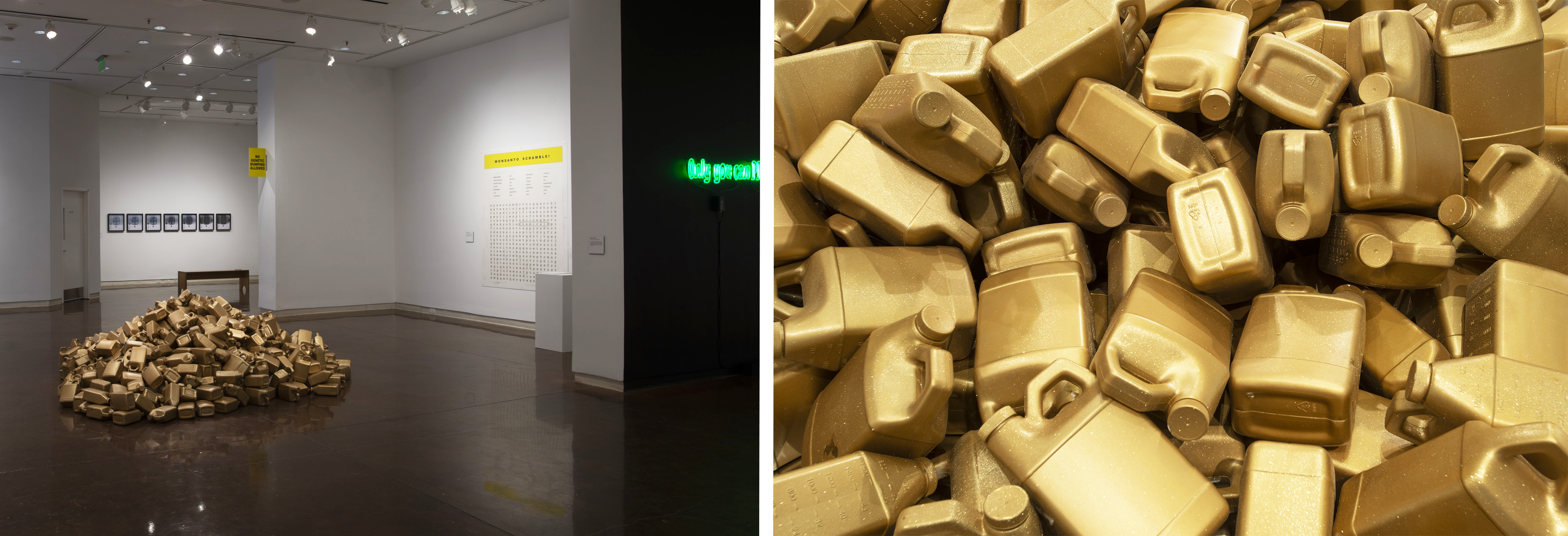


Our fall 2022 intern Gracie picked a few pieces in the Kirsten Stolle: Only You Can Prevent A Forest exhibition to draw our attention towards. Using appropriation, wordplay, and humor, Asheville-based artist Kirsten Stolle co-opts advertising strategies used by agrichemical corporations to resurface and critique company history. For her exhibition, Stolle created eye-catching photo-based collages, visual poetry interventions, text-based sound animation, a neon wall piece, and her first site-responsive sculptural installation.

Only You Can Prevent A Forest
Neon wall sculpture, 7’ x 10”, 2022
Not only the title of the exhibition, but also the precedence of a piece. Only You Can Prevent A Forest, a green, neon sculpture contrasted against a black wall. It is the first piece you are confronted with when you enter the Halsey Institute’s galleries. Upon seeing the piece, you consider what it reads, “Only You Can Prevent A Forest.” The text panel explains that this was the unofficial motto of the US military’s chemical warfare program. It was a play on words from the Smokey Bear campaign “Only You Can Prevent Forest Fires.” Seeing this phrase in glowing, green, neon does something more to the experience than if it were just regular text on a banner. Another representation in this exhibition of Kirsten Stolle’s mastery in using material and color to convey meaning. The green glow is reminiscent of a forest. The use of neon makes me think of its common use in advertising. It’s something we see on a day-to-day basis, but personally I have never seen it used to expose the horrific tactics of the US military. I think it is a brilliant way to use an understandable language to serve and digest the US’s detrimental use of herbicides to kill entire forests and fields of crops during the Vietnam War.

Pesticide Pop
Archival pigment print with laminated, Dibond, 44” x44” each, 2022
As you enter the Halsey Institute’s galleries, your attention is pulled from the left by a wall wrapped with huge pesticide bottles and bright colors. Pesticide Pop is a body of work featuring 10 images of various pesticides, herbicides, and weed killers illuminated by bright and colorful backgrounds. The use of such beautiful colors for some pesticide bottles immediately made me think why. There is so much intention in all of Kirsten’s works, nothing is without purpose. This body of work in particular is using a page in advertising’s book on eye-catching designs and memorable visuals. In reality, companies concoct the perfect amount of imagery, text, and color for the advertisement, in hopes of blissfully distracting consumers from the reality of the product. In this case, the danger of the product. In full realization of this, Kirsten Stolle has used the same imagery and colors straight from the agrichemical companies’ advertising to turn these toxic weed killers into glorified objects of desire. Through this work the company’s strategies of seduction are made into a realization of its own absurdity. By making the work this scale, Kirsten has ensured the realization continues as you read the print that is now visible and in your face – “DANGER-PELIGRO”, “KEEP OUT OF THE REACH OF CHILDREN”, “HARMFUL”, “WARNING” – only some of the language seen whilst adorned atop of the hot pink, blue, and shimmering gold backgrounds. Kirsten has created a visual representation of the contradiction in the agrichemical advertising and morals, as an accessible realization of the ironic destruction. For once I found myself reading the fine print and digesting what it actually meant. The truth in how it kills nature and has the power to kill us too.

Plant Protection
Plastic bottles, gold glitter, mirrored platform, 70” x 60”, 2022
500 glittering, gold pesticide bottles piled on top of a mirrored platform. This site-specific installation, Plant Protection,immediately strikes an internal conversation and interest about what it could signify. It definitely gives the feeling that it is something to be admired. It’s the color. Kirsten is a master at using color to convey meaning. Gold is a color that is full of information. Its viewers become admirers. Gold is precious, valuable, it can be sacrament. But what does gold do when it is covering empty pesticide bottles? Kirsten Stolle is investigating agrichemical corporate greed. Gold represents the greed of making money despite the detrimental effects to the natural world and us. The absurdity of a pile of 500, empty, golden pesticide bottles in the middle of the floor in Chalsty Gallery matches the absurd greed of these companies. Putting these “wonder chemicals” before all else, and to what end?